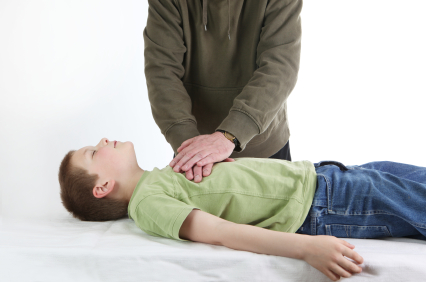Nearly 350,000 people suffer sudden cardiac arrest (SCA) annually. Permanent brain damage and even death can occur with approximately eight minutes or less after SCA. Because SCA is responsible for the death of one youth athlete every three days in the United
States, sports parents should know how to perform CPR and
use an AED, which can significantly increase a victim's chances of survival.

How does CPR work?
CPR (cardiopulmonary resuscitation) helps to restart the heart and lungs by using chest compressions and mouth-to-mouth breathing techniques. When it is performed correctly, CPR can save a child's life by keeping the blood flow moving to the brain, heart and other essential organs.
Steps to perform CPR
1. Check the scene to determine if you can perform CPR safely.
2. Verify breathing and heart rate to make sure that there is no response.
3. If the victim is not responsive, call 9-1-1 and locate an AED.
- If you are alone, perform five CPR cycles (30 chest compressions to 2 breaths) before leaving the victim.
4. Begin chest compressions:
- Position the heel of one or two hands on the lower part of the center of the chest.
- Start compressions by pressing down to at least 1/3 the depth of the chest (or two inches).
- Allow the chest to move back up after the compression so that the heart can fill with blood.
5. Once you have completed 30 compressions open the airway by tilting the head back with one hand on their forehead and use the other hand to lift the chin.
6. Give two breaths that are one second long. You will want to see the chest rise during the breath. If it does not then you should reposition the head and try again.
7. Continue with 30 more chest compressions and two ventilations.
You should continue administering CPR until one of the following happens:
- There are signs of life (such as breathing).
- An AED becomes available.
- Trained paramedics or emergency responders arrive and take over care.
- You are too exhausted to continue.
If two people are available, you can switch after 5 CPR cycles. This can minimize fatigue. Switch during the compression portion (the first person does twenty compressions before switching to the second person, who finishes the compressions and gives the rescue breaths) in order to minimize no-flow time.

An AED should be used on a child who is not responsive, not breathing, and does not have a pulse. Using an AED can increase survival rates by more than 60 percent, and it is useful to note that it will not deliver a shock unless it is needed therefore needless shocks should not be a concern.
1. Start by turning on the AED. Follow the instructions on the device carefully.
2. Remove any moisture (such as sweat) or met
3. Attach the electrode pads (use pediatric pads if available) to the child's bare chest. al (such as jewelry) from the victim's body.
4. Place one pad directly below the collarbone on the upper right side of the chest.
5. Put the other pad a few inches under the left armpit to the left of the nipple.
6. Hook up the wires to the AED and press analyze. Make sure that no one is touching the victim during the analysis.
7. The AED will analyze the cardiac rhythm and administer a shock if it is needed. Again, be sure that no one is touching the victim when the device administers a shock.
8. Do not remove the AED from the victim.
After using the AED, check for signs of life. If there are none, immediately resume CPR for five cycles (30 chest compressions to 2 breaths) before allowing the AED to reanalyze the victim.
Next steps
Everyone who has children or works with children should consider taking a CPR class. The good news is, getting trained does not have to take that long. Studies have shown that even just 20 minutes of CPR training is as effective as a four-hour class. There are a number of in-person and online classes and materials that you can use to brush up on the basics.
Do you know CPR or do you have plans to get certified? Share your thoughts below.
John Perkins is a marketing manager and writes frequently about health and wellness topics.
Posted June 27, 2013








